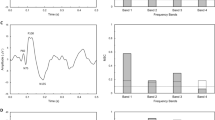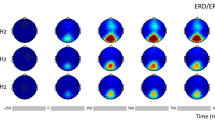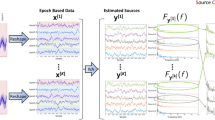Abstract
The VESPA (visual-evoked spread spectrum analysis) method estimates the impulse response of the visual system using a continuously varying stimulus. It has been used recently to address both basic cognitive and neurophysiologic questions as well as those surrounding clinical populations. Although the components of the average VESPA response are highly reminiscent of the early components of the visual-evoked potential (VEP) when measured over midline occipital locations, the two responses are acquired in different ways and, thus, they cannot be regarded as being equivalent. To further characterize the relationship between the VESPA and the VEP and the generative mechanisms underlying them, we recorded EEG from 31 subjects in response to checkerboard-based VEP and VESPA stimuli. We found that, across subjects, the amplitudes of the VEP C1 component and the VESPA C1 component were highly correlated, whereas the VEP P1 and the VESPA P1 bore no statistical relationship. Furthermore, we found that C1 and P1 amplitudes were significantly correlated in the VESPA but not in the VEP. We believe these findings point to the presence of common generators underlying the VESPA C1 and the VEP C1. We argue further that the VESPA P1, in light of its strong relationship to the VESPA C1, likely reflects further activation of the same cortical generators. Given the lack of correlation between the VEP P1 and each of these three other components, it is likely that the underlying generators of this particular component are more varied and widespread, as suggested previously. We discuss the implications of these relationships for basic and clinical research using the VESPA and for the assessment of additive-evoked versus phase-reset contributions to the VEP.




Similar content being viewed by others
References
Albrecht DG, Hamilton DB (1982) Striate cortex of monkey and cat: contrast response function. J Neurophysiol 48:217–237
Ales JM, Yates JL, Norcia AM (2010) V1 is not uniquely identified by polarity reversals of responses to upper and lower visual field stimuli. Neuroimage 52:1401–1409
Avidan G, Harel M, Hendler T, Ben-Bashat D, Zohary E, Malach R (2002) Contrast sensitivity in human visual areas and its relationship to object recognition. J Neurophysiol 87:3102–3116
Bartels A, Zeki S, Logothetis NK (2008) Natural vision reveals regional specialization to local motion and to contrast-invariant, global flow in the human brain. Cereb Cortex 18:705–717
Başar E (1999) Brain function and oscillations, principles and approaches. Springer, Berlin
Baseler HA, Sutter EE, Klein SA, Carney T (1994) The topography of visual evoked response properties across the visual field. Electroencephalogr Clin Neurophysiol 90:65–81
Boynton GM, Engel SA, Glover GH, Heeger DJ (1996) Linear systems analysis of functional magnetic resonance imaging in human V1. J Neurosci 16:4207–4221
Butler PD, Martínez A, Foxe JJ, Kim D, Zemon V, Silipo G, Mahoney J, Shpaner M, Jalbrzikowski M, Javitt DC (2007) Subcortical visual dysfunction in schizophrenia drives secondary cortical impairments. Brain 130(Pt 2):417–430
Carandini M, Demb JB, Mante V, Olshausen RA, Tolhurst DJ, Dan Y, Gallant JL, Rust N (2005) Do we know what the early visual system does? J Neurosci 25:10577–10597
Cheng K, Hasegawa T, Saleem SK, Tanaka K (1994) Comparisons of neuronal selectivity for stimulus speed, length, and contrast in the prestriate visual cortex areas V4 and MT of the macaque monkey. J Neurophysiol 71:2269–2280
Clark VP, Fan S, Hillyard SA (1995) Identification of early visual evoked potential generators by retinotopic and topographic analyses. Hum Brain Mapp 2:170–187
Contreras D, Palmer L (2003) Response to contrast of electrophysiologically defined cell classes in primary visual cortex. J Neurosci 23:6936–6945
Delorme A, Makeig S (2004) EEGLAB: an open source toolbox for analysis of single-trial EEG dynamics including independent component analysis. J Neurosci Methods 134:9–21
Di Russo F, Martínez A, Sereno MI, Pitzalis S, Hillyard SA (2001) Cortical sources of the early components of the visual evoked potential. Hum Brain Mapp 15:95–111
Di Russo F, Pitzalis S, Spitoni G, Aprile T, Patria F, Spinelli D, Hillyard SA (2005) Identification of the neural sources of the pattern-reversal VEP. NeuroImage 24:874–886
Fortune B, Hood DC (2003) Conventional pattern-reversal VEPs are not equivalent to summed multifocal VEPs. Invest Ophthalmol Vis Sci 44:1364–1375
Foxe JJ, Simpson GV (2002) Flow of activation from V1 to frontal cortex in humans. A framework for defining “early” visual processing. Exp Brain Res 142:139–150
Foxe JJ, Strugstad EC, Sehatpour P, Molholm S, Pasieka W, Schroeder CE, McCourt ME (2008) Parvocellular and magnocellular contributions to the initial generators of the visual evoked potential: high-density electrical mapping of the “C1” component. Brain Topogr 21:11–21
Frey HP, Kelly SP, Lalor EC, Foxe JJ (2010) Early spatial attentional modulation of inputs to the fovea. J Neurosci 30:4547–4551
Gawne TJ, Martin JM (2002) Response of primate visual cortical neurons to stimuli presented by flash, saccade, blink, and external darkening. J Neurophysiol 88:2178–2186
Geisler WS, Albrecht DG (1997) Visual cortex neurons in monkeys and cats: detection, discrimination, and identification. Vis Neurosci 14:897–919
Goodyear BG, Menon RS (1998) Effect of luminance contrast on BOLD fMRI response in human primary visual areas. J Neurophysiol 79:2204–2207
Gruber WR, Klimesch W, Sauseng P, Doppelmayr M (2005) Alpha phase synchronization predicts P1 and N1 latency and amplitude size. Cereb Cortex 15:371–377
Handy TC (2004) Event-related potentials: a methods handbook. MIT Press, Cambridge
James AC (2003) The pattern-pulse multifocal visual evoked potential. Invest Ophthalmol Vis Sci 44:879–890
Jeffreys DA, Axford JG (1972) Source locations of pattern-specific components of human visual evoked potential. I. Components of striate cortical origin. Exp Brain Res 16:1–21
Kelly SP, Gomez-Ramirez M, Foxe JJ (2008) Spatial attention modulates initial afferent activity in human primary visual cortex. Cereb Cortex 18:2629–2636
Klistorner A, Crewther DP, Crewther SG (1997) Separate magnocellular and parvocellular contributions from temporal analysis of the multifocal VEP. Vision Res 37:2161–2169
Klistorner AI, Graham SL, Grigg J, Balachandran C (2005) Objective perimetry using the multifocal visual evoked potential in central visual pathway lesions. Br J Ophthalmol 89:739–744
Lakatos P, O’Connell MN, Barczak A, Mills A, Javitt DC, Schroeder CE (2009) The leading sense: supramodal control of neurophysiological context by attention. Neuron 64:419–430
Lalor EC, Foxe JJ (2009) Visual evoked spread spectrum analysis (VESPA) responses to stimuli biased towards magnocellular and parvocellular pathways. Vis Res 49:127–133
Lalor EC, Pearlmutter BA, Reilly RB, McDarby G, Foxe JJ (2006) The VESPA: a method for the rapid estimation of a visual evoked potential. Neuroimage 32:1549–1561
Lalor EC, Kelly SP, Pearlmutter BA, Reilly RB, Foxe JJ (2007) Isolating endogenous visuo-spatial attentional effects using the novel Visual Evoked Spread Spectrum Analysis (VESPA) technique. Eur J Neurosci 26:3536–3542
Lalor EC, Yeap S, Reilly RB, Pearlmutter BA, Foxe JJ (2008) Dissecting the cellular contributions to early visual sensory processing deficits in schizophrenia using the VESPA evoked response. Schizophr Res 98:256–264
Lalor EC, Pearlmutter BA, Foxe JJ (2009) Reverse correlation and the VESPA method. In: Handy TC (ed) Brain signal analysis: advances in neuroelectric and neuromagnetic methods. MIT Press, Cambridge
Lalor EC, Kelly SP, Foxe JJ (in review) Generation of the VESPA response to rapid contrast fluctuations is dominated by striate cortex: evidence from retinotopic mapping
Lehmann D, Skrandies W (1980) Reference-free identification of components of checkerboard-evoked multichannel potential fields. Electroenceph Clin Neurophysiol 48:609–621
Lu HD, Roe AW (2007) Optical imaging of contrast response in Macaque monkey V1 and V2. Cereb Cortex 17:2675–2695
Maddess T, James AC, Ruseckaite R, Bowman EA (2006) Hierarchical decomposition of dichoptic multifocal visual evoked potentials. Vis Neurosci 23:703–712
Makeig S, Westerfield M, Jung TP, Enghoff S, Townsend J, Courchesne E, Sejnowski TJ (2002) Dynamic brain sources of visual evoked responses. Science 295:690–694
Mäkinen V, Tiitinen H, May P (2005) Auditory event-related responses are generated independently of ongoing brain activity. Neuroimage 24:961–968
Mazaheri A, Jensen O (2006) Posterior alpha activity is not phase-reset by visual stimuli. Proc Natl Acad Sci USA 103:2948–2952
Murray MM, Foxe JJ, Higgins BA, Javitt DC, Schroeder CE (2001) Visuo-spatial neural response interaction in early cortical processing during a simple reaction time task: a high-density electrical mapping study. Neuropsychologia 38:828–844
Noesselt T, Hillyard SA, Woldorff MG, Schoenfeld A, Hagner T, Jäncke L, Tempelmann C, Hinrichs H, Heinze HJ (2002) Delayed striate cortical activation during spatial attention. Neuron 35:575–587
Rolls ET, Baylis GC (1986) Size and contrast have only small effects on the responses to faces of neurons in the cortex of the superior temporal sulcus of the monkey. Exp Brain Res 65:38–48
Rousselet GA, Husk JS, Bennett PJ, Sekuler AB (2007) Single-trial EEG dynamics of object and face visual processing. Neuroimage 36:843–862
Sauseng P, Klimesch W, Gruber WR, Hanslmayr S, Freunberger R, Doppelmayr M (2007) Are event-related potential components generated by phase resetting of brain oscillations? A critical discussion. Neuroscience 146:1435–1444
Sayers BM, Beagley HA, Henshall WR (1974) The mechanism of auditory evoked EEG responses. Nature 247:481–483
Schroeder CE, Tenke CE, Givre SJ, Arezzo JC, Vaugh HG Jr (1991) Striate cortical contribution to the surface-recorded pattern-reversal VEP in the alert monkey. Vision Res 31:1143–1157
Schroeder CE, Steinschneider M, Javitt DC, Tenke CE, Givre SJ, Mehta AD, Simpson GV, Arezzo JC, Vaughan HG Jr (1995) Localization of ERP generators and identification of underlying neural processes. Electroencephalogr Clin Neurophysiol Suppl 44:55–75
Schroeder CE, Mehta AD, Givre SJ (1998) A spatiotemporal profile of visual system activation revealed by current source density analysis in the awake macaque. Cereb Cortex 8:575–592
Sclar G, Maunsell JHR, Lennie P (1990) Coding of image contrast in central visual pathways of the macaque monkey. Vis Res 30:1–10
Shah AS, Bressler SL, Knuth KH, Ding M, Mehta AD, Ulbert I, Schroeder CE (2004) Neural dynamics and the fundamental mechanisms of event-related brain potentials. Cereb Cortex 14:476–483
Slotnick SD, Klein SA, Carney T, Sutter E, Dastmalchi S (1999) Using multi-stimulus VEP source localization to obtain a retinotopic map of human visual cortex. Clin Neurophys 110:1793–1800
Sutherland A, Crewther DP (2010) Magnocellular visual evoked potential delay with high autism spectrum quotient yields a neural mechanism for altered perception. Brain 133(Pt 7):2089–2097
Tootell RBH, Reppas JB, Kwong KK, Malach R, Born RT, Brady TJ, Rosen BR, Belliveau JW (1995) Functional analysis of human MT and related visual cortical areas using magnetic resonance imaging. J Neurosci 15:3215–3230
Tootell RB, Hadjikhani NK, Vanduffel W, Liu AK, Mendola JD, Sereno MI, Dale AM (1998) Functional analysis of primary visual cortex (V1) in humans. Proc Natl Acad Sci USA 95:811–817
Whittingstall K, Logothetis NK (2009) Frequency-band coupling in surface EEG reflects spiking activity in monkey visual cortex. Neuron 64:281–289
Whittingstall K, Bartels A, Singh V, Kwon S, Logothetis NK (2010) Integration of EEG source imaging and fMRI during continuous viewing of natural movies. Magn Reson Imaging 28:1135–1142
Zhang X, Hood DC (2004) A principal component analysis of multifocal pattern reversal VEP. J Vis 4:32–43
Acknowledgments
We are grateful to Mr. James Barrett for assistance with data collection. This study was supported in part by a grant from the United States National Institute of Mental Health (MH085322 to J.J.F.). Additional salary support to E.C.L was provided by a Government of Ireland Postdoctoral Research Fellowship from the Irish Research Council for Science, Engineering and Technology.
Author information
Authors and Affiliations
Corresponding author
Rights and permissions
About this article
Cite this article
Murphy, J.W., Kelly, S.P., Foxe, J.J. et al. Isolating early cortical generators of visual-evoked activity: a systems identification approach. Exp Brain Res 220, 191–199 (2012). https://doi.org/10.1007/s00221-012-3129-1
Received:
Accepted:
Published:
Issue Date:
DOI: https://doi.org/10.1007/s00221-012-3129-1




